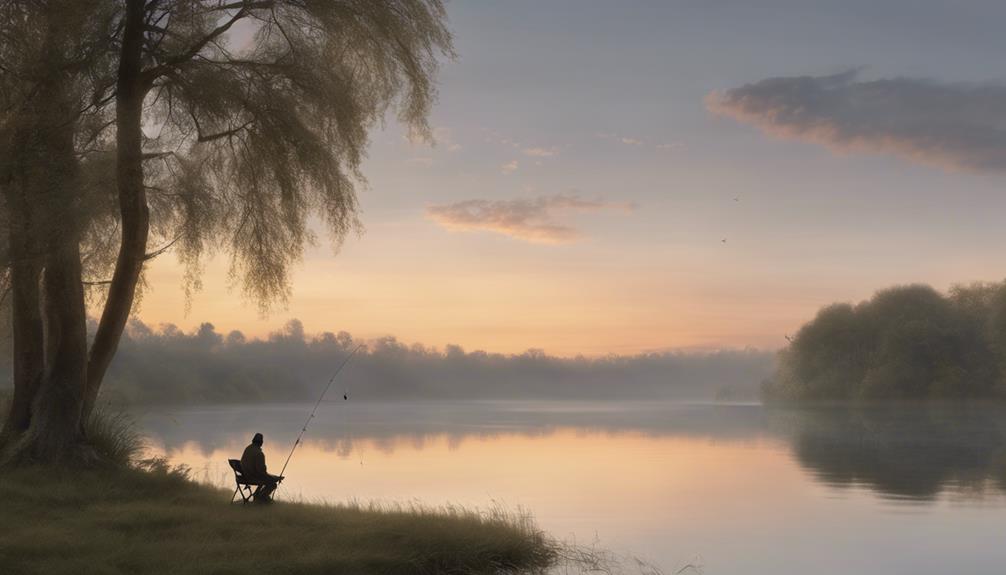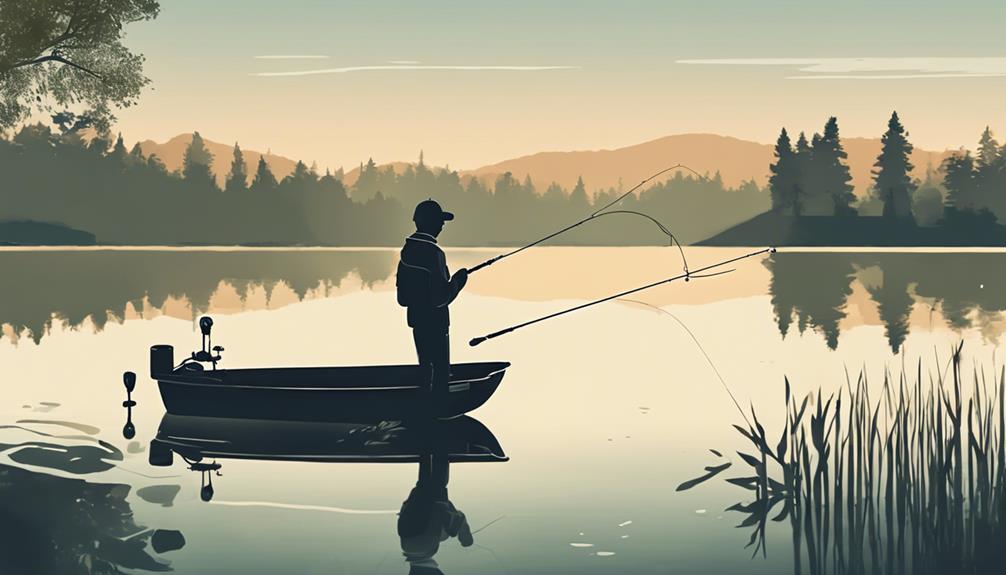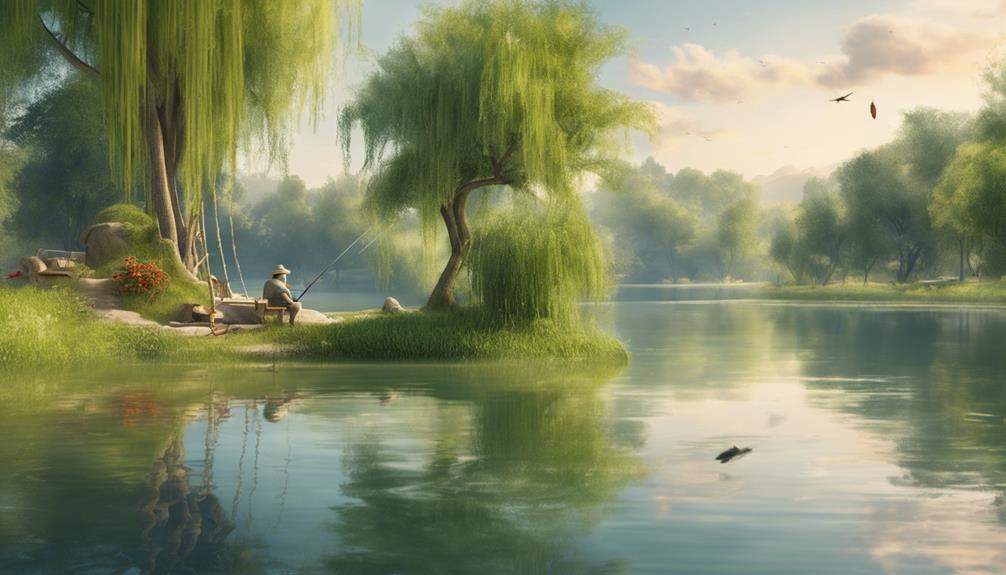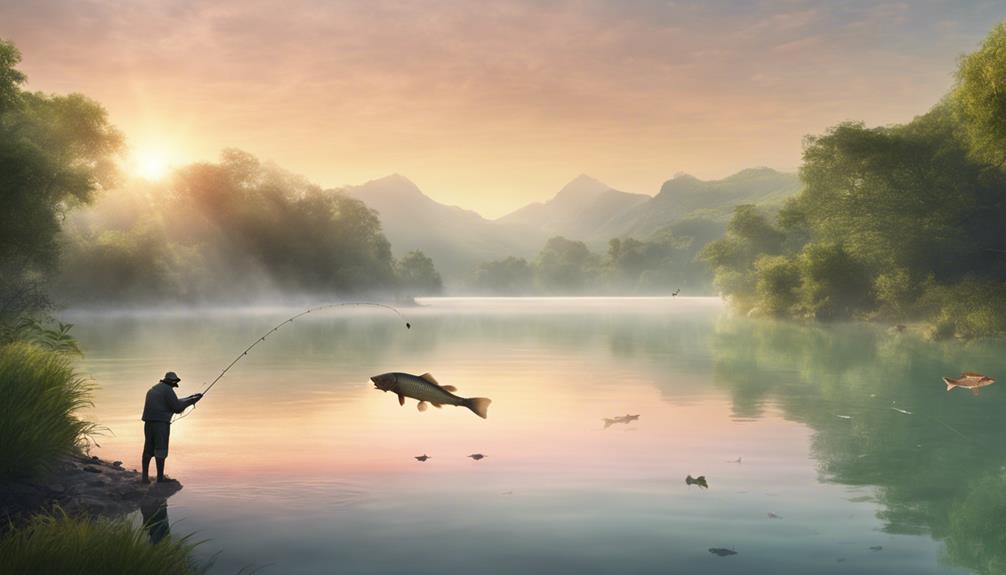To succeed in carp fishing as a beginner, start by learning carp behavior and adjust tactics accordingly. Select durable gear with smooth drag systems, and use strong, abrasion-resistant lines. Experiment with scented baits like sweetcorn and adapt to seasonal variations. Master accurate overhead casting and practice different techniques in varying conditions. Set up reliable rigs with hair rigs for stealthy hooking. Locate carp hotspots near vegetation and depth changes. Develop patience, persistence, and adaptability to anticipate carp movements. Handle carp properly for fish safety. These beginner tactics pave the way for a successful carp fishing adventure.
Understanding Carp Behavior
To successfully catch carp, you must first understand their behavior patterns and feeding habits. Carp are known for their diverse feeding patterns, which can vary based on seasonal variations and habitat. Understanding these nuances is crucial for a successful fishing experience.
Carp are omnivorous fish, feeding on a wide variety of food sources. Their feeding habits can change throughout the year due to seasonal variations. In the warmer months, carp are more active and tend to feed closer to the water's surface, while in colder months, they may move to deeper waters and feed less frequently. By recognizing these seasonal changes in feeding behavior, you can adjust your fishing techniques accordingly.
Habitat plays a significant role in carp behavior. Carp prefer slow-moving or still waters with plenty of vegetation where they can find food and shelter. They're bottom-feeders, often foraging for insects, crustaceans, and plant matter. Knowing where to locate these habitats in your fishing area can greatly increase your chances of a successful catch.
Selecting the Right Gear
Understanding carp behavior is fundamental when selecting the right gear for carp fishing, as it directly influences your choice of equipment and fishing approach. To ensure successful carp fishing, your gear must be in top condition. Proper gear maintenance is crucial. Regularly check your rods, reels, lines, and hooks for any signs of wear and tear. Clean your gear after each use, paying special attention to removing any dirt or debris that could affect its performance.
When it comes to tackle storage, organization is key. Invest in a tackle box with compartments to keep your hooks, sinkers, swivels, and other tackle items neatly sorted. This won't only make it easier for you to find the right tackle quickly but also help prolong the life of your gear by preventing damage or entanglement.
Consider the specific requirements of carp fishing when selecting your gear. Opt for sturdy rods with a good casting distance to reach the desired fishing spots where carp are likely to gather. Choose reels with smooth drag systems to handle the powerful runs of carp. Your line should be strong and abrasion-resistant to withstand the carp's rough mouth and underwater obstacles.
Choosing the Best Bait
Consider incorporating a variety of proven bait options to maximize your chances of enticing carp during your fishing expeditions. Bait presentation plays a crucial role in attracting carp. When choosing your bait, keep in mind that carp have a keen sense of smell and taste. Opt for baits that release strong scents underwater, such as sweetcorn, boilies, or pellets. These baits can pique the interest of carp and lure them towards your hook.
Seasonal variations greatly affect carp behavior and feeding habits. In spring and summer, carp are more active and tend to feed closer to the surface. Floating baits like bread crusts or dog biscuits can be highly effective during these seasons. On the other hand, during fall and winter, carp move to deeper waters. Boilies, which sink slowly and release attractants over time, are a good choice for colder months.
Experimenting with different bait sizes, colors, and flavors can help you determine what works best in different conditions. Keep in mind that carp can be picky eaters, so being adaptable with your bait selection is key. By understanding bait presentation and adapting to seasonal variations, you can enhance your chances of a successful carp fishing trip.
Mastering Casting Techniques
When honing your carp fishing skills, refining your casting techniques is fundamental to effectively reaching distant feeding areas and maximizing your chances of a successful catch. To practice accuracy in your casts, start by mastering the overhead cast. This technique involves smoothly propelling the bait towards your desired spot with precision. Focus on a fluid motion, releasing the line at the right moment to achieve accuracy.
Another crucial aspect is improving distance in your casts. To achieve this, work on your casting power by utilizing the pendulum cast. This method generates momentum by swinging the bait back before launching it forward. Timing and technique play key roles in maximizing the distance you can reach. Remember to release the line at the peak of your cast for optimal results.
Additionally, consider the importance of your rod position during casting. Keep it at a comfortable angle to facilitate a smooth and controlled motion. Practice in different conditions to adapt your technique to varying wind speeds and obstacles.
Regularly practicing your casting techniques won't only enhance your skills but also increase your chances of hooking a carp. By focusing on accuracy and distance, you'll be well on your way to mastering this essential aspect of carp fishing.
Setting Up Your Rig
To set up your rig effectively for carp fishing, begin by selecting a sturdy and reliable rod and reel combination that can handle the weight and strength of these powerful fish. Choose a rod with a test curve of around 2.75-3.5lbs for adequate strength. Match this with a quality reel that has a smooth drag system to tire out the carp during the fight.
When it comes to rig assembly, consider using a hair rig setup, which is a popular choice among carp anglers. This rig consists of a baited hook with the bait attached away from the hook, allowing the carp to feed without feeling the weight of the hook.
For tackle selection, opt for a mainline that's at least 12lbs in strength to handle the intense battles with carp. Fluorocarbon or monofilament lines are good choices due to their abrasion resistance and low visibility underwater. Pair this with a suitable hook size, usually between 6-10, depending on the bait used and the size of the carp in the water you're fishing.
Ensure your terminal tackle, such as swivels and beads, are reliable and strong to withstand the force of a hooked carp. Attention to detail in rig assembly and tackle selection can significantly increase your chances of landing a prized carp.
Locating Carp Hotspots
Begin by surveying the water's surface for signs of carp activity such as bubbling, jumping, or tail patterns, indicating potential hotspots for targeting these elusive fish. Carp are known to be cautious and easily spooked, so a stealthy approach is crucial when trying to locate their hotspots.
Here's how you can effectively identify these areas:
- Observe Water Movement: Look for subtle ripples or patches of calm water that could signal carp feeding below the surface. These areas are likely hotspots where carp are actively searching for food.
- Check for Vegetation: Carp are often found near aquatic vegetation such as lily pads, reeds, or submerged plants. These areas provide cover and attract insects, a staple in a carp's diet.
- Depth Variation: Carp tend to prefer areas with varying depths. Look for drop-offs, underwater structures, or changes in bottom composition as these are likely spots where carp congregate.
- Sun and Shade: In sunny weather, carp may seek shaded areas to avoid direct sunlight. Overhanging trees, bridges, or structures casting shadows on the water can be potential hotspots.
Reading water is an art that comes with experience. Understanding the subtle clues nature provides can significantly improve your chances of locating carp hotspots. By combining a stealthy approach with a keen eye for detail, you'll be on your way to finding the perfect spot to lure in these prized fish.
Patience and Persistence

Exercising unwavering patience and relentless persistence is paramount in mastering the art of carp fishing, ensuring a fruitful and rewarding angling experience. Developing the skills of patience and persistence is crucial when it comes to carp fishing. Carp are known for their cautious and sometimes unpredictable behavior, making it essential to remain calm and composed while waiting for the right moment to strike. Building confidence in your abilities to wait for extended periods without losing focus is key to a successful carp fishing outing.
To develop your patience, start by understanding the behavior of carp in different conditions. Learn to interpret their movements and feeding patterns, which will help you anticipate their behavior and adjust your approach accordingly. Patience isn't just about waiting but about actively observing and analyzing the environment to make informed decisions.
Persistence is equally important. Carp can be picky eaters, so it may take several attempts before you find the right bait or technique that works. Don't get discouraged by initial failures; instead, see them as opportunities to learn and improve. Keep experimenting with different rigs, baits, and locations until you find what works best for you.
Proper Carp Handling
Mastering proper carp handling techniques is fundamental for ensuring the well-being of the fish and maintaining a sustainable fishing environment. When you catch a carp, remember that how you handle it can greatly impact its survival after release. Follow these guidelines to ensure you handle carp correctly:
- Gentle Release: After landing a carp, avoid dragging it on rough surfaces or squeezing it tightly. Hold the fish gently and support its weight properly to reduce stress and potential injuries. A stressed fish is more susceptible to diseases and may have difficulties recovering after release.
- Safe Handling: When handling a carp, wet your hands before touching it to protect the fish's delicate skin. Avoid placing your fingers in the carp's gills or eyes. Use tools like a landing net or a fish-friendly mat to minimize direct contact and prevent unnecessary harm.
- Conservation Efforts: Always prioritize the well-being of the fish. If you need to unhook the carp, do it swiftly and efficiently using appropriate tools. Minimize air exposure and handle the fish with care to increase its chances of survival once back in the water.
- Proper Equipment: Ensure you have the right tools for handling carp, such as forceps for hook removal and a suitable unhooking mat. Being prepared with the correct equipment will help you handle the fish safely and effectively, contributing to the preservation of carp populations for future generations.
Frequently Asked Questions
How Can I Prevent Other Fish From Stealing My Bait?
To prevent other fish from stealing your bait, focus on bait protection. Use bait security measures like using larger hooks or baits that are harder for smaller fish to snatch.
Place your bait strategically to deter competing fish, such as near structures where carp are more likely to frequent. By ensuring your bait is secure and positioned strategically, you can increase your chances of attracting carp while minimizing interference from other fish.
What Is the Best Way to Handle Windy Weather While Carp Fishing?
When fishing in windy conditions, your casting accuracy is crucial for successful bait presentation. To handle windy weather effectively while carp fishing, adjust your casting technique by aiming lower and using heavier bait. This will help combat the wind's effect and ensure your bait lands where you intend.
Additionally, consider using a heavier sinker to keep your bait in place despite the windy conditions, increasing your chances of attracting carp.
Are There Any Specific Colors of Bait That Carp Prefer?
When targeting carp, consider the most effective bait colors and seasonal preferences. Carp are known to be attracted to bright colors like yellows, oranges, and pinks.
In spring and summer, lighter shades can work well, mimicking natural food sources like insects. As fall arrives, darker hues such as browns and greens might be more appealing to carp.
Experiment with different colors to see what works best in your fishing area.
Should I Use a Leader When Fishing for Carp?
When fishing for carp, using a leader offers several benefits. It helps prevent line breakage due to the abrasive mouth of carp and provides better control over the fish during the fight.
Additionally, a leader can improve bait presentation by allowing the bait to move more naturally in the water.
How Do I Avoid Getting Tangled Lines When Fishing in a Group?
When fishing in a group, managing your lines effectively is crucial to prevent tangles. Coordinate with your team members to establish designated areas and casting directions. Utilize hand signals or verbal communication to ensure everyone is on the same page. Maintain proper spacing between anglers to minimize the risk of crossed lines.
Conclusion
Now that you have learned the beginner's tactics for successful carp fishing, it's time to put your knowledge into practice.
Remember to observe carp behavior, select the right gear, choose the best bait, master casting techniques, set up your rig, locate carp hotspots, be patient and persistent, and handle carp properly.
With practice and dedication, you'll soon be reeling in those prized carp like a seasoned angler.
Happy fishing!



